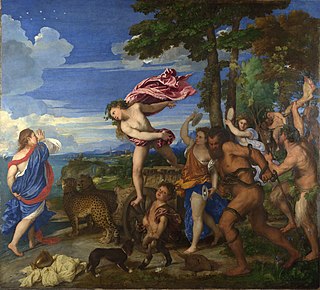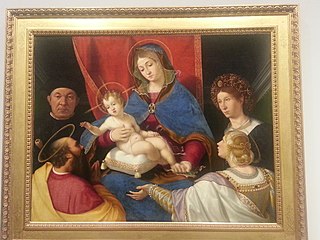 W
WAdoration of the Christ Child is an oil on panel painting produced in 1523 by Lorenzo Lotto and signed at the bottom right "L. Lotus / 1523". It is now in the National Gallery of Art in Washington.
 W
WAdoration of the Magi is a c.1522-1523 oil on panel painting by Pontormo, produced for the antechamber of Giovan Maria Benitendi's palazzo in Florence and now in the Galleria Palatina in the same city.
 W
WThe Bacchanal of the Andrians or The Andrians is an oil painting by Titian. It is signed "TICIANUS F.[aciebat]" and is dated to 1523–1526.
 W
WBacchus and Ariadne (1522–1523) is an oil painting by Titian. It is one of a cycle of paintings on mythological subjects produced for Alfonso I d'Este, Duke of Ferrara, for the Camerino d'Alabastro – a private room in his palazzo in Ferrara decorated with paintings based on classical texts. An advance payment was given to Raphael, who originally held the commission for the subject of a Triumph of Bacchus. At the time of Raphael's death in 1520, only a preliminary drawing was completed and the commission was then handed to Titian. In the case of Bacchus and Ariadne, the subject matter was derived from the Roman poets Catullus and Ovid.
 W
WThe Casotti Madonna or Madonna and Child with Saint Paul, Saint Agnes and Donors is an oil on panel painting by Andrea Previtali now in the Accademia Carrara in Bergamo, commissioned in 1523 by Paolo Casotti, a rich merchant from Bergamo, the artist's native city.
 W
WHoly Family with the Infant Saint John the Baptist is a c.1522-1523 oil on panel painting by Pontormo, produced early in his career. It now hangs in the Hermitage Museum, which acquired it with countess E. I. Mordvinova's collection. A preparatory drawing survives in the Uffizi's Gabinetto dei Disegni e delle Stampe.
 W
WThe Shrine of Santa Maria della Steccata is a Greek-cross design Renaissance church in central Parma, Italy. The name derives from the fence or steccato used to corral the numerous devotees who visited a venerated image of the Madonna. A Nursing Madonna is enshrined within, crowned on 27 May 1601 by a Marian devotee, Fray Giacomo di Forli of the Capuchin order.
 W
WMadonna and Child with Saint Jerome and Saint Nicholas of Tolentino is a 1523-1524 oil on canvas painting by Lorenzo Lotto. It is known to have been in the Dawkins collection in Oxford between 1911 and 1955, before passing to the Heinemann collection in New York. In 1960 it passed to its present owner, the Museum of Fine Arts, Boston, which also owns a workshop version of his Mystic Marriage of St Catherine.
 W
WMadonna of the Cat is a 1522-1523 oil on wood painting by Giulio Romano, now in the National Museum of Capodimonte in Naples.
 W
WThe Madonna of the Stairs is a fresco fragment by Correggio, dating to around 1522-1523 and now in the Galleria Nazionale di Parma.
 W
WMarriage of the Virgin or the Ginori Altarpiece is a 1523 oil on panel painting by Rosso Fiorentino, signed and dated by the artist. It was commissioned by Carlo Ginori for the chapel dedicated to the Virgin Mary and saint Joseph - previously owned by the Masi family that chapel had been acquired by the Ginori family in 1520. It still hangs in the Basilica, whilst a drawn copy attributed to Antonio Circignani is now in the Louvre (n.1592).
 W
WMystical Marriage of St Catherine of Alexandria with Niccoló Bonghi is an oil painting by Lorenzo Lotto in the Collections of the Accademia Carrara, Bergamo, Italy.
 W
WThe Portrait of Alfonso I d'Este is a now-lost painting by Titian, dating to 1523. It was painted as a pendant to the Portrait of Laura Dianti of the same year and is now known through copies, one of which is by Rubens and another of which is held at the Metropolitan Museum of Art in New York. Others are held in the collections of the countess of Vogüe Commarin at Dijon and the Statens Museum for Kunst in Copenhagen - the latter is the oldest but only shows the head and shoulders.
 W
WHans Holbein the Younger painted the Portrait of Erasmus of Rotterdam several times, and his paintings were much copied, at the time and later. It is difficult to disentangle Holbein's original work from that of his workshop and other copyists. Possibly five largely original versions survive, as well as a number of drawings made as studies.
 W
WPortrait of Marsilio Cassotti and His Bride Faustina is a 1523 oil on panel painting by Lorenzo Lotto, now in the Prado Museum in Madrid. It is signed and dated "L. Lotus Pictor / 1523". It is the first known marriage portrait produced in Italy, inspired by prints from Germany and the Low Countries.
 W
WSan Giovanni Evangelista is a church in Parma, northern Italy, part of a complex also including a Benedictine convent and grocery.
 W
WSan Giovanni Evangelista is a church in Parma, northern Italy, part of a complex also including a Benedictine convent and grocery.
 W
WSaint Barbara is a c.1523 oil on panel painting by Parmigianino, now in the Prado Museum in Madrid. Copies of it are in the Mauritshuis, Pomona College and Chatsworth House.
 W
WThe Shrine of Santa Maria della Steccata is a Greek-cross design Renaissance church in central Parma, Italy. The name derives from the fence or steccato used to corral the numerous devotees who visited a venerated image of the Madonna. A Nursing Madonna is enshrined within, crowned on 27 May 1601 by a Marian devotee, Fray Giacomo di Forli of the Capuchin order.
 W
WSaint John the Baptist as a Boy is a c.1523 oil on panel painting by Andrea del Sarto, now in the Palatine Gallery of the Palazzo Pitti in Florence.
 W
WSan Giovanni Evangelista is a church in Parma, northern Italy, part of a complex also including a Benedictine convent and grocery.
 W
WSan Giovanni Evangelista is a church in Parma, northern Italy, part of a complex also including a Benedictine convent and grocery.
 W
WThe Villa La Pelucca frescoes are a 1520-1523 cycle of frescos by Bernardino Luini, commissioned by the Milanese nobleman Gerolamo Rabia for his villa near Monza, known as 'La Pelucca'. Most of the surviving fragments are in the Pinacoteca di Brera in Milan, though others are in the Wallace Collection in London, the Louvre in Paris, the Musée Condé in Chantilly and other private collections. Stylistically they shown the influence of Bramantino - Women Bathing the figure's shoulders is a homage to the Trivulzio Tapestries, particularly February from that cycle.